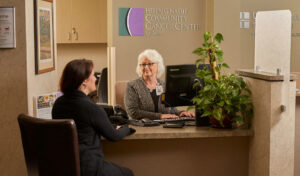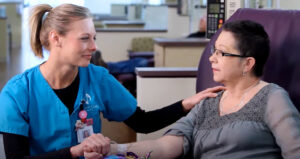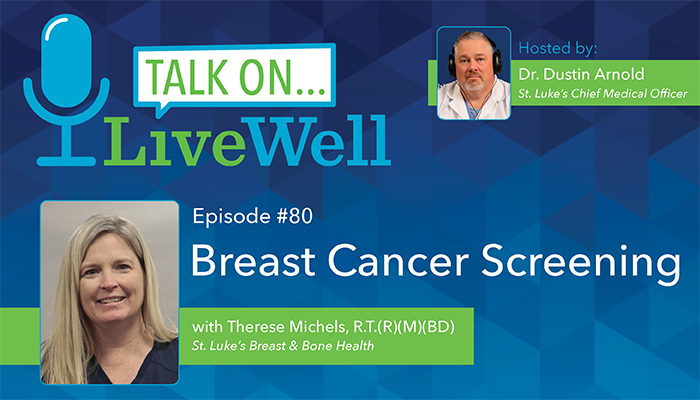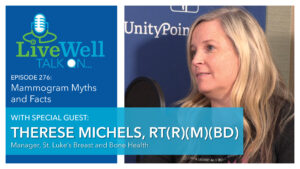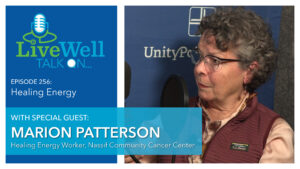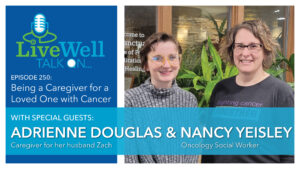Therese Michels, R.T.(R)(M)(BD), manager at St. Luke’s Breast & Bone Health, joins Dr. Arnold to discuss breast cancer screening mammogram recommendations for women.
Subscribe on: Apple Podcasts | Google Podcasts | Spotify | iHeart Radio | Pandora | SoundCloud | Stitcher | TuneIn
Host
Dr. Dustin Arnold
Chief Medical Officer
UnityPoint Health – St. Luke’s Hospital
Guests:
Therese Michels
Manager
St. Luke’s Breast and Bone Health
Transcript
Dr. Arnold:
This is LiveWell Talk On…Breast Cancer Screening. I’m Dr. Dustin Arnold, chief medical officer at UnityPoint Health-St. Luke’s Hospital. Early detection leads to the best survival rates with breast cancer. Joining me today on this topic is Therese Michaels manager of St. Luke’s Breast and Bone. Welcome. You know, I think let’s just start off with what age would it be recommended that a woman would start to have screening mammograms?
Therese Michels:
Well that can be based on family history, but the average woman to start screening mammograms would be first one between 35 and 40. That’s if your family history is pretty, you know non-coherent with the guidelines.
Dr. Arnold:
So meaning that family history contains other relatives that have had breast cancer?
Therese Michels:
Correct. So any blood relatives that have breast cancer, especially first degree like mother, sister, daughter, those are considered first degree. So if you have any of those, you should consult with your provider about when to start. Some people start as early as 30, just dependent on that. But average baseline mammography starts between 35 and 40.
Dr. Arnold:
You run into the same thing that we run into with diabetes. You have the American Diabetic Association, you have the Society of Endocrine. They have different definitions and at times different recommendations for diabetes and they’re both very credible. I think you run into that too with breast cancer screening, don’t you?
Therese Michels:
We do. We do quite a bit. As far as our department goes, you know, of course the basic standard is early detection is the best for early prevention. You want to find things small, but there are some different standards and guidelines out there with different. Like for instance, we go by the ACR, which is American College of Radiology and the NCCN, which is National Comprehensive Cancer Network. Those accrediting bodies require you to do 40 and above screening every year where there’s some more conservative ones out there that say every two years.
Dr. Arnold:
Well, okay. Independent of the cost of the screening exam, what is the risk to having a mammogram? I’m sure it’s uncomfortable, you know, that goes without saying, but are there any other downsides?
Therese Michels:
Well, the downside with uncomfortable, that has improved quite a bit over the last years. We’re starting to see on the market curved paddling, which is more conforming to the breast. Which St. Luke’s does have. So if you asked a lady that had it 20 years ago versus 20 years from now, they’re saying that it’s a lot more comfortable. It is pressure. The other downsides to it would be really, there’s no risk or any risks that has been recorded because as far as the radiation goes, it is very highly regulated. It’s probably one of the highest regulated fields out there with radiation. So we have yearly physicists’ tests. We are very regulated by the state. We’re regulated by the FDA, so we run tests yearly for that. So basically your radiation intake for one mammogram is a lot less than if you were to fly on an airplane across the United States.
Dr. Arnold:
Yeah. So that’s closely watched and lower risks radiation exposure. And I think overall that’s the direction of radiology to limit radiation exposure. I think we’ve talked about it more than we did when I first started practicing medicine 22 years ago. Sometimes I hear women have dense tissue and then they may recommend like an MRI. Can you tell me about that?
Therese Michels:
Dense tissue is something that’s been newly, you know, we’ve known about it for a while, but for patients it’s becoming more of a law where we allow patients to know what their level of dense tissue is. The state of Iowa passed the law about a year, two years ago, where in your letter, your result letter, you are notified of how denture tissue is. Dense tissue is basically where the patient’s breast is made up of glandular tissue, which is technically where the dense tissue falls into. And then there’s fatty. So on a mammogram, fatty looks black. Breast tissue, the dense tissue looks white. So basically it’s almost like looking through fog and you’re trying to find a polar bear in fog. So when you have more dense tissue than the fatty tissue, it can tend to obscure some things that may be small and growing in there. So we have other tests that can help that too. As far as screening goes.
Dr. Arnold:
What are those tests?
Therese Michels:
The first one is, automated breast ultrasound. That is where it’s a 3D image of your breast by ultrasound, which is sound waves. And it’s an automated system where it goes back and forth and scans in different planes and kind of penetrates that dense tissue a little bit better. So that has been up and coming I think.
Dr. Arnold:
Is that the same as 3D mammography?
Therese Michels:
3D, it’s the same kind of visual plane but it kind of looks at the breast in a different way.
Dr. Arnold:
Okay. Alright. When does an MRI get requested?
Therese Michels:
Breast MRI is a little more in depth. That also sometimes includes an injection. So with those, those are definitely more expensive. We’re not seeing as many insurance companies covering that. So we do that when the family risk is more. So if you have both ,where dense tissue is and you have a higher family risk factor we start looking more details into the breast MRI for those kind of patients.
Dr. Arnold:
And if I’m a woman who has dense tissue at the age of 36 do I lose that over time? Does it become less dense or is that just something that is with them?
Therese Michels:
It can definitely become less dense because the estrogen levels kind of drop in the patients. So we start seeing more of a decrease in the post-menopausal, peri-menopausal age. There’s some very few, but there are some that continue to have that kind of dense tissue throughout their lives.
Dr. Arnold:
So at some point do you just as a center, you recommend that they just go right to some sort of enhanced mammography to begin with? Or do you always have to start with basic mammography and work through?
Therese Michels:
Well, at St. Luke’s we have 3D mammography, which is basically, if you think about a loaf of bread and you cut a bunch of slices through it. So we’re taking that one picture and we’re developing it into 80 to a hundred thin slice layers of your breasts. It’s almost like a cat scan where they can break it down and look at it layer by layer. So that now for us as a standard of care at St. Luke’s. So we do provide that for all patients to come up forth. So that helps with the dense tissue. And then after that, you know, it’s recommended if we recommend the dense tissue like the ABUS, we go into those modalities as well.
Dr. Arnold:
So if my patient or loved one has mammography that’s abnormal or normal, how soon am I notified?
Therese Michels:
Usually within the first 24 hours. We’re seeing patients leave our facility and within two hours they’re getting a text notification on their cell phone. And that’s usually patients that are signed up for the patient portal where they receive that information online. If you are getting called back or if there’s a diagnostic problem where they need to do more detailed pictures, we usually call you within the next two days and set you up for that.
Dr. Arnold:
So it’s rather quick. I can’t imagine a patient would want to be left wondering whether or not they have cancer. If a mass or nodule is felt on self-examination as well as perhaps by the family practitioner, does that still get a mammogram first or does it go straight to biopsy?
Therese Michels:
It definitely goes to mammogram first. Mammogram is always the golden standard to find something. But it would start off as a diagnostic mammogram. So diagnostic mammogram, compared to a routine screening mammogram, is you come in and you get the test done and you are already set up for an ultrasound if that is needed. And then you’re also getting the results before you leave our facility that day. So if it does go into a biopsy, you are scheduled for that before you leave our office.
Dr. Arnold:
So in summary, the age to start at if you’re high risk is 35.
Therese Michels:
Correct.
Dr. Arnold:
The age to start at if you’re not high risk is 40?
Therese Michels:
Well the baseline you do between 35 and 40 and then starting at 40, you do a mammogram every year.
Dr. Arnold:
Ok and when did you say we stopped doing mammograms?
Therese Michels:
We stop doing mammograms, we basically, we definitely do have a lot of questions with that because of our aging population in this area. We do get a lot of patients asking that. When they come in and ask us that, we usually say, first of all, it’s up to you and your provider because your provider knows your history best. Second thing is if you were, or if somebody were to find a cancer in your breast, are you healthy enough to have that surgery? Are you healthy enough to have that excised out? And if your answer to that is yes, then we prefer that you do it every year.
Dr. Arnold:
Okay. You know with prostate screening you reach a certain age as a male and you’re going to die from something else and that’s why they quit screening for prostate cancer at a certain age. You know, but prostate is very slow for the most part, there’s exceptions. It’s a slow growing cancer. Breast can be very quick and time is of the essence. So a good screening definitely leads to early detection which improves survival.
Therese Michels:
Correct. Correct. Definitely. I mean again, early detection is the best prevention and there is different kinds of growing cancers. There’s fast growing and they’re slower growing so you just don’t know what you’re going to deal with until it gets biopsied.
Dr. Arnold:
Yeah. I would say my surgical colleagues tend to move pretty quickly when a patient has breast cancer to get it surgically removed, if that’s what’s needed. That’s not something they tend to delay. 1% of breast cancer is men. Is there anything men should be doing for screening?
Therese Michels:
Men should definitely. And you know, again there’s some different studies out there as far as self breast exam, but they should definitely be checking too because they can definitely be affected by that. Recently we had a male that had precancerous cells in there because of lumps. But they can also have, most common is what’s gynecomastia, so that is not non-cancerous, but they should also definitely be just doing a self exam as well.
Dr. Arnold:
Okay. One last question. How’d you end up in breast and bone and the cancer center?
Therese Michels:
Yeah, it was kind of more of a personal choice and actually going through it personally with my mom. I started x-ray school, but then during that she was diagnosed with breast cancer and this was back in the 90s when there was probably not as much updated things with prevention. She passed away when she was 44. So it just started that increase of knowledge for that. So right out of x-ray school, I basically went into mammography and been in it ever since.
Dr. Arnold:
Wow, that’s neat. Yeah, one thing about breast cancer, and this is just from my point of view, but I think most men share this is, it’s someone’s mom, daughter or sister, and so you tend to move quickly on it or wife. Which is for the best obviously, but I think it had just has a heightened sense of something that we should be doing something about.
Therese Michels:
Definitely. Definitely. It’s one of the highest causes of cancers out there for sure.
Dr. Arnold:
It always blows my mind, like back in the 1950s, culturally, like you wouldn’t talk about it if you had cancer. It just totally, it’s unfathomable, but that’s the way it was. You know, you kind of held that. You didn’t talk about it because there was a stigmata with having cancer of any sort. That’s just so not true these days.
Therese Michels:
Yes. We’ve had women before that won’t even tell their own husbands back then, that they were being treated for that. It was very, I mean, very common for that. But now we’re starting to see this newer generation come in knowing their background history. Which now they can be tested for our genes, genetics. We have genetic counseling, onboard bracketing tests, so stuff you’ve never heard of before. And as far as prevention it is just not as invasive as it used to be as well.
Dr. Arnold:
Which is for the better. Well, this is really great information today. Thanks so much for taking time to talk to us about this important topic. Again, this was Therese Michels manager of St. Luke’s breast and bone. For more information, visit unitypoint.org if you have a topic you’d like to suggest for our live well talk on podcast, shoot us an email at stlukescr@unitypoint.org and we encourage you to tell your family, friends, neighbors about our podcast. Until next time, be well.
